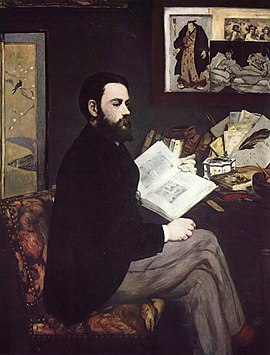Émile Zola, whom we will encounter many times in this course, was one of the most prominent French novelists of the second half of the 19tyh century, As the most prominent exponent of naturalism in literature, he felt a comradship with the Impressionisrs, whose efforts to capture in painting the exterior world as it actually appeared to them he saw as parallel to his own form of writing. Blow is part of a newspaper article in which he defends the Impressionists against attacks from conservative critics.
|
These last few years something very interesting and instructive has been happening under our own
This
is, then, what the Impressionist painters have to offer: a more
exact examination of the causes and effects of light, exerting
its influence both on color and design. They have been
justifiably accused of drawing their inspiration from Japanese
prints.... It is certain that our dark schools of painting, the
bituminous-minded work of our established schools, has been
surprised and forced to rethink things when faced with the
limpid horizons, the beautiful vibrant spots of the Japanese
water-colorists. There was in these works a simplicity of means
and an intensity of performance which struck our young artists
and drove them on to this path of painting soaked in air and
light a path which all the talented newcomers take today. . . . The great
pity is that this new formula which they all bring scattered in
their works, not one of the artists of the group has realized it
powerfully and definitively. The formula is there, endlessly
divided; but nowhere, in any one of them, do we find it applied
by a master. ...
Yet, while we can take objection to their personal
incapacity, they remain none the less the true representatives
of our time. They have plenty of gaps, their workmanship is too
often slack, they are too easily satisfied, they show themselves
to be incomplete, illogical, exaggerated, ineffectual. No
matter: it is enough for them to apply themselves to
contemporary naturalism in order to find themselves at the head
of a movement and play a great part in our school of painting. |
